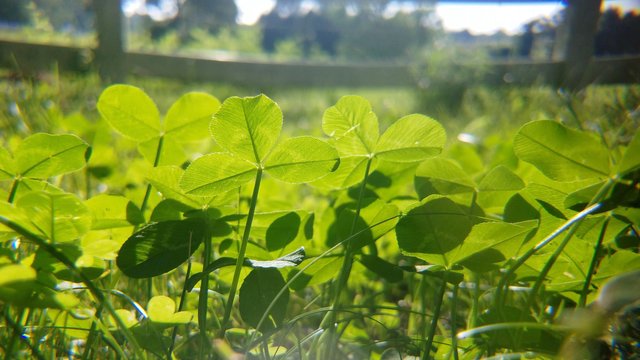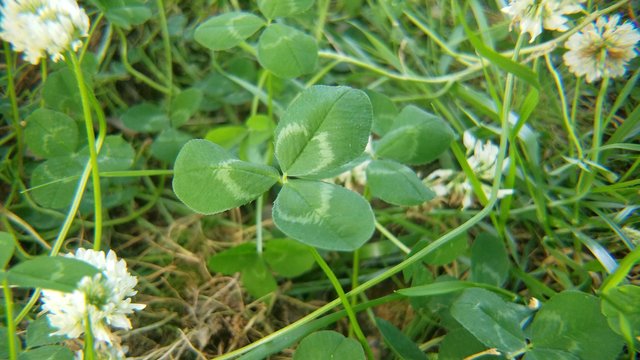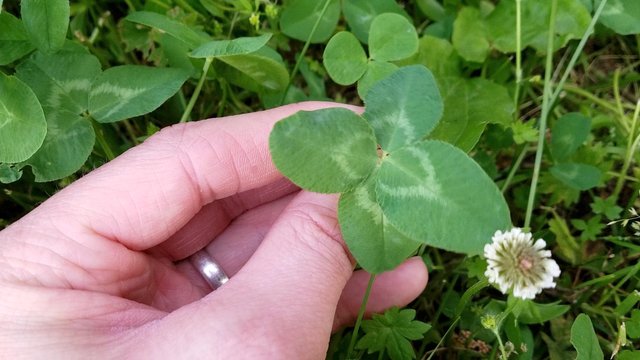*Trifolium repens* and The Luck of The Irish
Trifolium repens and The Luck of The Irish

Original Image
You may not realize it, but clover is one of the coolest plants in the yard. All plants require nitrogen in order to produce amino acids and chlorophyll, and most have to get their nitrogen from the soil. Clover is special in that regard, because it is a nitrogen fixing plant. Nitrogen fixers develop a special symbiotic relationship with bacteria from the genus Rhizobium. The bacteria infects the roots of the plant where it is able to begin drawing nitrogen from the air. Some of the nitrogen can then be used by the plant, and the excess is stored in little nodules on the plant’s roots. Later, when the plant dies, it releases that stored nitrogen back into the soil. This ability makes clover (especially the winter-hardy red clover) an excellent choice for an off-season cover crop in the garden or pasture.
It is also an important plant for honeybees. A recently published study from the journal Scientific Reports suggests that bees with access to white clover forage (in association with sunflower, canola, and alfalfa) have healthier colonies than those who do not. I have also read claims from honey producers that, due to the sheer volume of flowers produced per acre by clover, it is essential for producing enough nectar to support colonies of bees.

Can You Eat It?
A quick Google search on white clover would indicate that it is a good wild edible and medicinal herb. Apparently, the plant is edible from root to tip; however, it is not considered a choice edible. It is recommended that the root be cooked before consumption. Young leaves may be eaten raw, but they supposedly acquire a bitter flavor as they age. It is advised that boiling them can rid them of their acrid flavor. Flowers may be eaten immediately after being picked. I read from several sources that if the blossoms are not consumed within 30 minutes or so of harvesting, they should be left to dry for 4-6 weeks. Dried flowers are said to have a slight vanilla flavor and may be ground into a flour or used to make an herbal tea. I decided to do a little taste test of my own. You know… FOR SCIENCE!If you’re interested in how that went, check out the video. But do note that, for reasons covered in the next section of this article, I was very careful about which individual plants I harvested for my sample session.
But SHOULD You Eat It?
So, you can eat white clover, but it is recommended that you consume it immediately or let it dry for several days before digging in. Furthermore, I found several adamant warnings against fermenting any part of the plant for culinary purposes. I couldn’t help but wonder what the danger would be; and, it took some digging, but I found the answer.I’m not going to try and tell you what you can or can’t eat, but if you choose to consume white clover, you should PROCEED WITH CAUTION!! If you’re like most of my 9th grade students who consider reading truncated article titles on the search return page to be thorough research, then you might miss some important information about how some variants of T. repens CAN PRODUCE HYDROGEN CYANIDE; a process called cyanogenesis. It does this as a response to physical damage - possibly as a defense system, or maybe as a self destruct mechanism.

Original Image
T. repens is polymorphic for cyanogenesis, which means that within a species, or even in your backyard, you will find some individuals that can produce cyanide and some that can not. The ability has been traced back to two separate genes, each controlled by a simple Mendelian two-allele dominant/recessive system. On one gene, having a dominant allele allows for the production of cyanoglucosides within the cells’ cytoplasm. Cyanoglucosides are sugars that bind a cyanide compound up in an innocuous form. On the other gene, having a dominant allele enables the production of linamarase, which is stored within the cell wall of each cell. Linamarase can break cyanoglucosides down, freeing the toxic hydrogen cyanide. In order to activate the protective powers of the cyanide compounds, cells must be destroyed so that they can release their linamarase, allowing it to break the toxic chemicals out o their cyanoglucoside shackles. If a plant is lacking the dominant phenotype at either gene location, it will be unable to produce the cyanogenic toxin.
The amount of cyanide produced in T. repens probably isn't enough to be deadly, especially to larger animals. It is more likely that it just makes the plant taste bad. From what I gather, this is why large grazing mammals seem to rather enjoy eating white clover. Smaller herbivores and insects, on the other hand, have shown a tendency to avoid cyanogenic clover opting for acyanogenic varieties, instead. Where a sheep or goat would chew up a mouthful of white clover leaves and swallow them rather quickly, a slug is a bit slower. It would begin eating a leaflet, causing cellular damage. Cyanide would be released into the leaf before the slimy little guy had time to finish its meal. No worries, though! It can just move on to the next plant.
Cyanogenesis is more common in clover variants found in warm climates. Scientists aren’t sure if this correlation is caused by temperature variations alone, or if the prevalence of grazing animals and other herbivores (like snails) in these warmer climates are the more likely cause for this trend. Interestingly, I found references claiming that clover with white stripes are cyanogenic, whereas clover lacking the white banding patterns are not. All of these references seemed to have come from the same initial source and seemed to be the basis for an AP Biology course experiment, so they may be legit. However, I would want to do a little more reading before I put them out there as fact. So, if you’re a person that insists on eating clover, maybe this is something you should look into.
Oh, and if the possible presence of hydrogen cyanide isn’t enough to make you think twice, you should also be aware that a lot of people are allergic to clover.
So, Should My Animals Eat Clover?
I don’t have a good data-driven answer to this question. I’m sure that the studies exist, but I was unable to find them or didn’t have access to them.Obviously, anecdotal evidence points to a large herbivorous mammal’s consumption of clover as being okay. It is probable that large animals like cattle and sheep are able to rid themselves of cyanide at a fast enough rate so that it doesn’t accumulate to dangerous levels. It is possible for them to build up too much of the toxin, but that is usually due to the consumption of other cyanogenic plants that produce larger doses of cyanide. Too much cyanide, or prussic acid poisoning as it is known, can be fatal. It disrupts the body’s ability to absorb oxygen into the lungs. Signs that your herd may be accumulating too much cyanide include labored breathing, irregular pulse, frothing at the mouth, and staggering. You can minimize the risks associated with prussic acid poisoning by avoiding grazing when forage crops may be damaged. This includes times during drought conditions and within two weeks of a nonkilling frost.
Why Clover Is Awesome
But, even if clover wasn’t so beneficial to nature or to beekeepers, it would still be one of my favorite plants. I couldn’t venture a guess as to how many hours I’ve spent playing in patches - as a kid, with my parents; and now as a parent with my kids - making chains out of the white, poofy flowers or searching for those elusive stems with four leaflets attached. Even when I’m just outside working, I find myself scanning the ground looking for four leaf clovers. I have become pretty good at spotting them, but I can’t help but notice how many clovers are not four-leaved. Why are they so rare? What makes some of them pop out that extra leaflet?

Original Image
Trifolium repens
White clover is found within the genus Trifolium, referring to its propensity to have three leaflets, with the specific epithet repens which translates to “creeping”. There are other types of clover within the Trifolium genus, and there are even other unrelated plants (notably from the genus Oxalis) that closely resemble clover; however, many regard Trifolium repens as the only clover to yield true, luck-bringing four leaf clovers.I’m Not Superstitions, But I Am A Little Stitious
For centuries, people worldwide have considered four leaf clovers to be lucky, but no one really knows why. I always just assumed that it originated with the idea that you were lucky to find one; however, there are actually several different origin stories. Apparently, around 200 B.C., Druids believed that carrying a four leaf clover would imbue one with the power to see demons and ward them off. In the middle ages, it would allow you to see fairies. Yet another legend posits that Eve smuggled a four leaf clover out of the Garden of Eden when she and Adam got the boot, so to have a four leaf clover is to possess a piece of paradise.
Meme Created Using imgflip
Side Note
I have to take a moment here to point something out. Perhaps you have noticed that I have been referring to the individual leaves on a clover as leaflets. I only learned this as I was researching for this article, but what we refer to as an entire clover constitutes a single palmately compound leaf. The stem of the clover is technically a petiole with leaflets attached. Palmately compound leaves may be unifoliate (a single leaflet), bifoliate (two leaflet), trifoliate (three leaflets), quadrifoliate (four leaflets), or multifoliate (more than four leaflets). Clover are most likely to form trifoliate palmately compound leaves; however, as we know, it is possible for them to be quadrifoliate or even multifoliate. In fact, the world record for the most leaflets ever found on a single T. repens petiole is an astonishing 56! It was found in Japan in 2009 by Shigeo Obara. The find broke his own previous record of 18 leaflets. Apparently, he cross-pollinated T. repens specimen trying to yield higher leaflet counts as a hobby. I would say that it worked!Causes Four For This Anomaly
Why don’t we know for sure? Well, the T. repens genome is very complex. It is an allotetraploid, which means that they have four chromosomes that come from two different species of plants. The resultant genome is so complex that scientists have difficulty developing algorithms that can study them.
Polyploidy generally occurs in nature when nondisjunction of chromatids occurs during meiosis. In other words, the chromosomes stuck together, resulting in gametes that contain a full copy of DNA instead of a half-copy. If a male gamete with a full copy of DNA fertilizes a female gamete with a full copy of DNA, the resulting offspring will have two full copies of DNA. We call this tetraploidy (having 4 chromosomes). If the male gamete and the female gamete happened to have come from different species, we refer to it as allotetraploidy.
Polyploidy is far more common in plants than in animals. A 1994 study estimated that anywhere from 30-70 percent of all plant species on Earth are polyploids, and a 1993 study suggests that about 75 percent of all domestic plants contain multiple sets of chromosomes. The reasons for this disparity, however, aren’t clear.
For T. repens, the event probably occurred when Trifolium pallescens and Trifolium occidentale cross pollinated, and each brought 2 chromosomes to the party.
Statistically Speaking
Apparently, the odds of finding a four-leaf clover are 1 in 10,000; although, I did find a study that claims the number to be closer to 1 in 5,000. However, neither of these numbers may be completely reliable for any practical purposes. As its name implies, T. repens is able to shoot out runners across the ground that can take root and produce a new genetic clone of the original plant. So, if a particular individual happens to have the genetic predisposition required to produce a four leaf clover, as it creeps outward in all directions carrying its genetics with it, that should increase the likelihood of finding multiple four leaf clovers within the same small area.But, just for poops and googles, what if we assume that the more prevalent stat, 1 in 10,000, is correct. How big of a clover-covered area would we have to search in order to find a four leafer? That’s what statistician Jim Frost wondered. So, him and his daughter did some backyard science to find out. They started by making a 6 in. by 6 in. guide that they placed on the ground in a dense patch of clover. Then, they painstakingly plucked every single clover that they saw within their 36 square inch boundary. They counted a total of 200 clovers. They did some math, extrapolated some data, and found that you would have to search through about 12.5 square feet of clover in order to encounter 10,000 of them. That would be a rectangle with sides roughly 3ft x 4ft. But, as Frost points out, finding a four leaf clover is not an independent event. Because producing quadrifoliate leaves is a genetic trait and those genetics are very likely to spread quickly due to the plant’s ability to propagate, finding a four leaf clover in an area actually increases your odds of finding more in the immediate surroundings.
Tips On Finding Four Leaf Clovers
I’ve always described my method of searching for four leaf clovers as:
- Having a mental image of what a three leaf clover looks like.
- Quickly scanning over a clover patch. (I do this by standing up and scanning a small 1ft x 1ft (give or take) area.)
- Look for things the do not match the three-leaf pattern.
It is difficult to describe, but when I spot a four leaf clover, I rarely ever single it out immediately. It’s more like this intuitive feeling of something not being quite right within a general area. I know that it is not intuition in the sense that I know something before experiencing it; I just think that humans - and most other animals - are that perceptive. At any given moment, we are receiving way more stimuli than we realize, and much of it is just useless noise. Your brain doesn’t feel the need to dwell on details that don’t matter, so there are a lot of things going on around us that we ”don’t see/hear”. It is called unconscious selective attention, and it is also the reason you don’t see the tip of your nose. I think the trick is to get that trifoliate pattern in your mind and fool your brain into thinking it is important. That way, things that don’t match the pattern stand out.
Granted, this is not a fool proof method. I’m sure I overlook a lot of four leafers. And, more often than not, when that intuition is triggered, it just turns out to be a three leaf clover with another leaf from a different clover lined up just right so that it tricks me. But, this method seems to be way more productive for me than plopping down in the middle of a clover patch and inspecting every single clover.
I am not a believer of luck, much less when it comes to an object, it is interesting to read this type of articles for the simple fact of learning a bit of everything and more if it is something from a point where you do not believe, the famous four leaf clovers are (from what I've heard) very hard to find, but once I found him with my uncle and it was something crazy, because he just said "Wow my niece has the best luck in the world" and I just thought "A plant Will you be lucky? " JAJA are my things. Excellent writing, you have a good lexicon.
This post was nominated by a @curie curator to be featured in an upcoming Author Showcase that will be posted in about 12 to 24 hours on the @curie blog.
NOTE: If you would like us to NOT feature your post in the Author Showcase please reply, or DM me on Discord as soon as possible. Any photos or quoted text from your post that we feature will be properly attributed to you as the author.
You can check out our previous Author Showcase to get an idea of what we are doing with these posts.
Thanks for your time and for creating great content.
Franz (@curie curator)
That's awesome! Thank you {:o)
I remember that we spent hours sitting on the ground looking for four-leaf clovers when I was a child. And we were successful. I had plenty of them dried out between pages of books at home. It was always so much fun. But I don't remember when I did it for the last time so thank you for the reminder.
I would never ever think about eating them. I don't know why but it has never crossed my mind. Now, after I read your post I would probably not risk it anyway :)
Thank you for sharing and have a nice day!
hi @sustainablyyours
very interesting post! I could not imagine how many informations are behind a clover! even poison: - ((, it amazes me that the animals do not suffer in any way.
I found some cloverleaf in the past, but not so many to tell the truth !!
do you do all these researches out of passion or for work?
congratulations on your curie vote and thanks for sharing
Hi sustainablyyours,
Visit curiesteem.com or join the Curie Discord community to learn more.
Clover here in India is a very un-popular kind of plant, I have mostly heared four-leaf clover word in hollywood music. I used to wonder what is it, then google told me its symbol of good luck and I believed maybe that is why it is used in song to refer lover. But now since I know Clover has to be eaten with Caution - I am again relating to Lover use in songs. hahaha I cant stop laughing on my weird thoughts. But thanks for sharing the actual science behind clover.
Congrats on your curie, well deserved. :):)
What a thorough and interesting post. Even though I usually get lost at scientific jargon, I kept reading this one. It was worth it.
Really fascinating facts about a rather insignificant plant (at least in my culture).
We do get the lucky reference from the media, cartoons, legends, etc. But very few people would contemplate or search a clover field here hunting for a 4-leaf clover.
Nature is amazing and complex and we have to tip our hats to those who venture in its study and understanding.
Trifolium repens is not only The Luck of The Irish, it is considered to bring luck all over Europe and maybe all over the world. I remember when we ere kids we used to search for the one having four leaves.
Looks like we were lucky as we were always finding some.
Reading your article made me realize how little I know about it. I didn't even know it's edible.